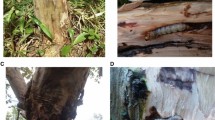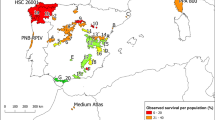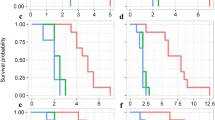Abstract
In a series of open field experiments, we studied the effects of two lepidopteran pests (Plutella xylostella and Crocidolomia pavonana) at equal population density on cabbage yield. Completely randomised plots were assigned to four treatments, replicated four times. Treatments were P. xylostella only, C. pavonana only, or P. xylostella and C. pavonana at 1:1 ratio at different phenological stages of cabbages and a control (without any caterpillars). The growth stages and applied densities were pre-heading, cupping and heading, with densities of 2, 4 and 6 larvae/plant, compared with control. The effects of the two species differed significantly in terms of both yield (P < 0.0001) and injury score (P < 0.0001) compared to the control, which produced 67.4 ± 5.79 t/ha of clean, marketable cabbage. Crocidolomia pavonana reduced yield by 68% (21.8 ± 0.82 t/ha) with no market value at a cumulative injury score of 5, while P. xylostella reduced the yield by 40% (40.4 ± 2.38 t/ha at a cumulative injury score of 3.5). The sequential infestation of cabbage by P. xylostella and C. pavonana reduced yield by 41%, with 39.4 ± 3.48 t/ha of marketable yield at a cumulative injury score of 4.4. Thus, C. pavonana is more damaging than P. xylostella under the same growing conditions. Hence, zero infestation is recommended during the seedling and transplanting stages of the cabbages. The findings can serve as a basis to establish an economic threshold for C. pavonana and modify a two-decade-old economic threshold for P. xylostella in Tanzania.
Similar content being viewed by others
Data availability
Data will be made available on request.
References
Agboyi LK, Ketoh GK, Martin T, Glitho IA, Tamò M (2016) Pesticide resistance in Plutella xylostella (Lepidoptera: Plutellidae) populations from Togo and Benin. Int J Trop Insect Sci 36:204–210. https://doi.org/10.1017/S1742758416000138
Ale B, Zalucki MP, Furlong MJ (2011) Host plant selection by Crocidolomia pavonana F. (Lepidoptera: Crambidae): effect of herbivory and adult experience, In: Srinivasan R, Shelton AM, Collins HL (eds.) Proceedings of the Sixth International Workshop on Management of the Diamondback Moth and Other Crucifer Insect Pests, AVRDC – The World Vegetable Center, Tainan, Taiwan, pp 70–75
Ang GCK, Silva R, Maxwell SL, Zalucki MP, Furlong MJ (2014) Contrary effects of leaf position and identity on oviposition and larval feeding patterns of the diamondback moth. Entomol Exp Appl 151:86–96. https://doi.org/10.1111/eea.12172
CAB International (1979) Crocidolomia binotalis (Distribution map). In: Distribution maps of plant pests, Wallingford, UK: CAB International. Map 236 (Revised). https://doi.org/10.1079/DMPP/20056600236
Dono D, Natawigena WD, Kharismansyah HR (2014) Resistance status of Crocidolomia pavonana F. (Lepidoptera: Crambidae) from Pasirwangi Garut, West Java to the insecticide profenofos and its susceptibility to the methanolic leaf extract of Nicotiana tabacum L. (Solanaceae). Journal of ISSAAS 20(2):121–130
Dreyer M (1987) Field and laboratory trials with neem products as protectants against pests of vegetable and field crops in Togo. In: Schmutterer H, Ascher KRS (eds.) Natural pesticides from the Neem Tree (Azadirachta indica A Juss). Proceedings of the Third International Neem Conference, 10- 15 July 1986. GTZ, Eschborn, FRG, Nairobi,Kenya, pp 431- 447
Erbaugh M (2005) Regional IPM Program for East Africa: Kenya, Tanzania and Uganda. In: Muniappan R, Vaughan L, Rich M, Kenny R (eds) Integrated Pest Management Collaborative Research Support Program FY 2006 Annual Report, Office of International Research, Education & Development (OIRED), Virginia Tech, Blacksburg, VA, USA, p 125
Ernest M, Njogu J (2011) The Brassica handbook. Kengap Publishing Ltd., Nairobi, Kenya
Furlong MJ, Wright DJ, Dosdall LM (2013) Diamondback moth ecology and management: problems, progress, and prospects. Annu Rev Entomol 58:517–541
Gautam MP, Singh H, Kumar S, Kumar V, Singh G, Singh SN (2018) Diamondback moth, Plutella xylostella (Linnaeus) (Lepidoptera: Plutellidae) a major insect of cabbage in India: A review. J Entomol Zool Stud 6(4):1394–1399
ICIPE (2020) Scaling-up biological control of the diamondback moth on Crucifers in Central and Southern Africa. http://www.icipe.org/research/plant-health/vegetable-ipm/projects/scaling-biological-control-diamondback-moth-crucifers. Accessed 12 July 2020
Karavina C, Mandumbu R, Zivenge E, Munetsi T (2014) Use of garlic (Allium sativum) as a repellent crop to control diamondback moth (Plutella xylostella) in cabbage (Brassica oleraceae var capitata). J Agric Res 52(4):615–621
Li ZY, Feng X, Liu SS, You MS, Furlong MJ (2016) Biology, ecology, and management of the diamondback moth in China. Annu Rev Entomol 61:277–296. https://doi.org/10.1146/annurev-ento-010715-023622
Li ZY, Furlong MJ, Yonow T, Kriticos DJ, Bao HL, Yin F, Lin QS, Feng X, Zalucki MP (2018) Management and population dynamics of diamondback moth (Plutella xylostella): Planting regimes, crop hygiene, biological control and timing of interventions. Bull Entomol Res 109(2):257–265. https://doi.org/10.1017/s0007485318000500
Lingappa S, Basavanagoud K, Kulkarni KA, Patil RS, Kambrekar DN (2004) A threat to vegetable production by diamondback moth and its management strategies. In: Mukerji KG (ed) Fruit and vegetable diseases. Springer, Dordrecht, pp 357–396. https://doi.org/10.1007/0-306-48575-3
Massomo SMS, Mabagala RB, Mortensen CN, Hockenhull J, Swai IS (2005) Cabbage production in Tanzania: challenges faced by smallholder farmers in the management of black rot disease. J Sustain Agr 26(4):119–141. https://doi.org/10.1300/J064v26n04_08
Moshi DJ, Tarimo TMC, Ndakidemi PA, Munishi L (2015) Health risks of pesticides to non-target species and the ecosystem due to control of migrant pests in Tanzania. J Res Environ Sci Toxicol 4(2):20-27. https://doi.org/10.14303/jrest.2015.131
Mpumi N, Machunda RS, Mtei KM, Ndakidemi PA (2020) Selected insect pests of economic importance to Brassica oleracea, their control strategies and the potential threat to environmental pollution in Africa. Sustainability 12(9):3824. https://doi.org/10.3390/su12093824
Ngowi AV, Mbise TJ, Ijani ASM, London L, Ajayi OC (2007) Pesticides use by smallholder farmers in vegetable production in northern Tanzania. Crop Prot 26(11):1617–1624. https://doi.org/10.1016/j.cropro.2007.01.008
Peter C, Singh I, ChannaBasavanna GP, Suman CL, Krishnaiah K (1988) Loss estimation in cabbage due to leaf webber Crocidolomia binotalis (Lepidoptera: Pyralidae). J Bombay Nat Hist Soc 85:642–644
Pretty J, Bharucha ZP (2015) Integrated pest management for sustainable intensification of agriculture in Asia and Africa. Insects 6:152–182. https://doi.org/10.3390/insects6010152
Saucke H, Dori F, Schmutterer H (2000) Biological and integrated control of Plutella xylostella (Lep. Yponomeutidae) and Crocidolomia pavonana (Lep. Pyralidae) in Brassica crops in Papua New Guinea. Biocontrol Sci Technol 10:595–606
Silva AX, Jander G, Samaniego H, Ramsey JS, Figueroa CC (2012) Insecticide resistance mechanisms in the green peach aphid, Myzus persicae (Hemiptera: Aphididae) I: a transcriptomic survey. PLoS One 7(6):e36366. https://doi.org/10.1371/journal.pone.0036366
Smyth RR, Hoffmann MP, Shelton AM (2003) Effects of host plant phenology on oviposition preference of Crocidolomia pavonana (Lepidoptera: Pyralidae). Environ Entomol 32(4):756–764. https://doi.org/10.1603/0046-225X-32.4.756
Srinivasan R, Shelton AM, Collins HL eds (2011) Proceedings of the Sixth International Workshop on Management of the Diamondback Moth and Other Crucifer Insect Pests, 21‐25 March 2011, Kasetsart University, Nakhon Pathom, Thailand. AVRDC – The World Vegetable Center, Publication No. 11‐755. AVRDC - The World Vegetable Center, Taiwan. p 321
Stern VM (1973) Economic thresholds. Annu Rev Entomol 18:259–280
Sulifoa JB, Fangupo S, Kant R (2016) Oviposition periodicity, egg morphology and life history of large cabbage moth Crocidolomia pavonana population in Samoa. The South Pacific Journal of Natural and Applied Sciences 34(2):29–34
Tadle FPJ (2016) Choice of feeding sites, growth and survival by Crocidolomia pavonana. A Thesis submitted for the Degree of Doctor of Philosophy at the University of Queensland, Australia. p 120
Talekar NS (1992) Management of Diamondback Moth and other crucifer pests. Shanhua, Taiwan: AVRDC
Uelese A, Ridland P, Stouthamer R, He YR, Ang G, Zalucki MP, Furlong MJ (2014) Egg parasitism of Crocidolomia pavonana (F.) (Crambidae) in Samoa: the potential of Trichogramma chilonis Ishii (Hymenoptera: Trichogrammatidae) as a biological control agent. Biol Control 73:31–38
Wearing CH, Thomas WP, Collyer E (1982) The decision to implement IPM: prerequisites and consequences. In: Cameron PJ et al. (eds). Proceedings of Australasian Workshop on development and implementation of IPM. Government Printer, Auckland. Available at: https://www.researchgate.net/publication/268208995_The_decision_to_implement_IPM_prerequisites_and_consequences (visited on 13th May 2020).
Zalucki MP, Adamson D, Furlong MJ (2009) The future of IPM: whither or wither? Australian J Entomol 48:85–96
Zalucki MP, Furlong MJ (2011) Predicting outbreaks of a migratory pest: an analysis of DBM distribution and abundance. In: Srinivasan R, Shelton AM, Collins HL (eds.) Proceedings of the Sixth International Workshop on Management of the Diamondback Moth and Other Crucifer Insect Pests, AVRDC – The World Vegetable Center, Tainan, Taiwan, pp 8–14
Zalucki MP, Shabbir A, Silva R, Adamson D, Shu-Sheng L, Furlong MJ (2012) Estimating the economic cost of one of the world’s major insect pests, Plutella xylostella (Lepidoptera: Plutellidae): just how long is a piece of string? J Econ Entomol 105:1115–1129
Zhu LH, Li ZY, Zhang SF, Xu BY, Zhang YJ, Zalucki MP, Wu QJ, Yin XH (2018) Population dynamics of diamondback moth (Plutella xylostella) in northern China: the effect of migration, cropping patterns and climate. Pest Manag Sci 74:1845–1853
Acknowledgement
Dr. Jacquline Mkindi (Executive Director of the Tanzania Horticultural Association), Dr. Thomas Dubois [former Regional Director, Eastern and Southern Africa (ESA) Region, World Vegetable Center (WorldVeg)], and Dr. Gabriel Rugalema (Regional Director, WorldVeg ESA) and their team are acknowledged for both material and moral support.
Funding
The research was supported from the long-term strategic donors to the World Vegetable Center: Republic of China (Taiwan), UK aid from the UK government, United States Agency for International Development (USAID), Australian Centre for International Agricultural Research (ACIAR), Germany, Thailand, Philippines, Korea, and Japan.
Author information
Authors and Affiliations
Contributions
Aaron Y. Mbogho: Developed the main conceptual ideas, carried out the experiments, analyzed the data and wrote the manuscript; Robert Mwashimaha, Omary Mbwambo, and Simon B. Boni: Provided the research support and contributed for revising the manuscript; Jacob Yarro, and Bruno Nyundo: Research supervision, and contributed for revising the manuscript; Myron P. Zalucki: Critically reviewed the results as well as the manuscript, and revised the manuscript; Ramasamy Srinivasan: Developed the main conceptual ideas and the project, and critically reviewed and revised the manuscript.
Corresponding author
Ethics declarations
Consent for publication
All authors have contributed significantly, and all authors are in agreement with the content of the manuscript. None of the material has been published or is under consideration elsewhere.
Conflict of interest
The authors declare no conflict of interest.
Rights and permissions
About this article
Cite this article
Mbogho, A.Y., Mwashimaha, R., Mbwambo, O. et al. Comparative effects of Plutella xylostella (L.) (Lepidoptera: Plutellidae) and Crocidolomia pavonana (F.) (Lepidoptera: Crambidae) on cabbage yield in Tanzania. Int J Trop Insect Sci 41, 2733–2738 (2021). https://doi.org/10.1007/s42690-021-00452-4
Received:
Accepted:
Published:
Issue Date:
DOI: https://doi.org/10.1007/s42690-021-00452-4




